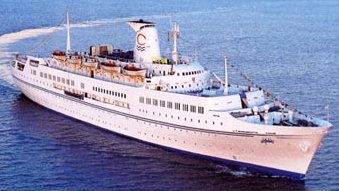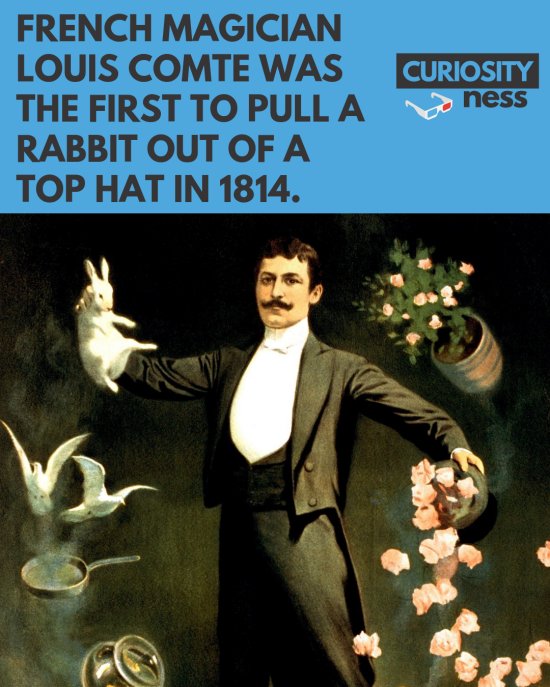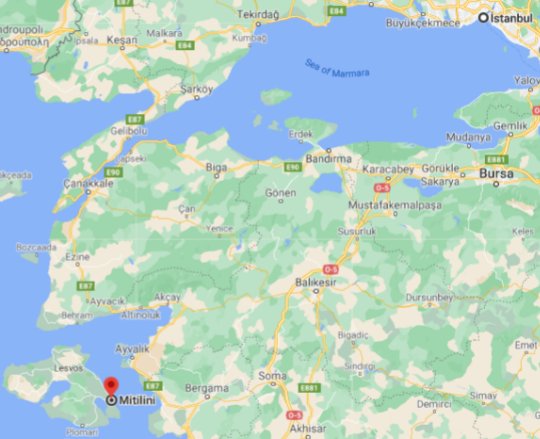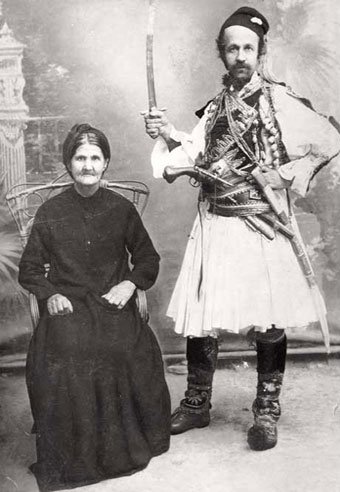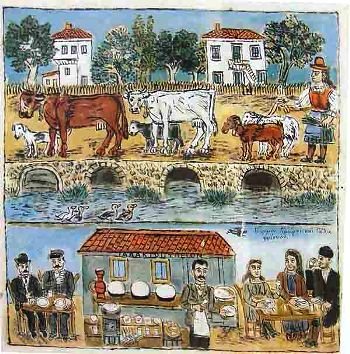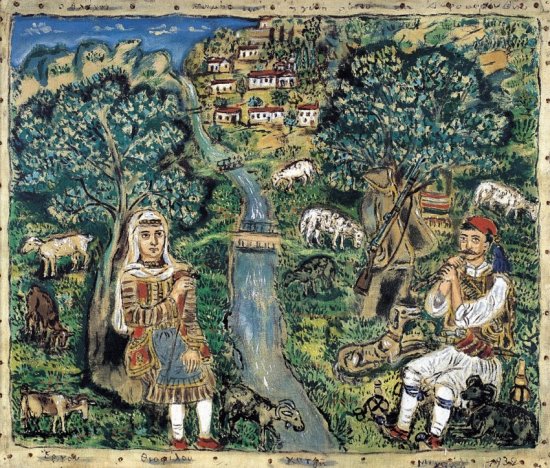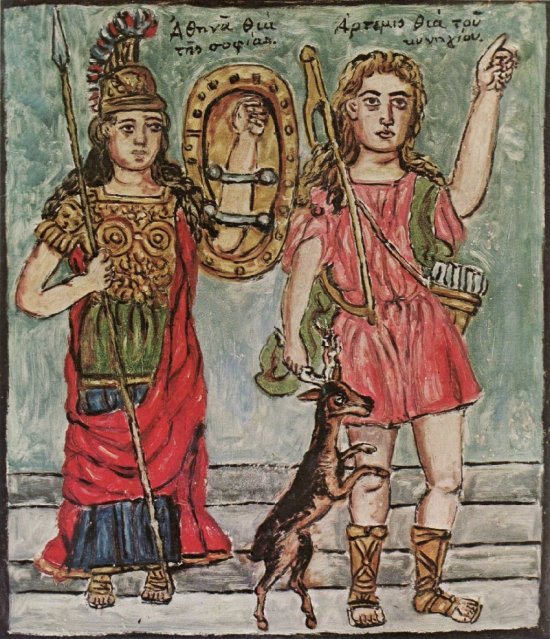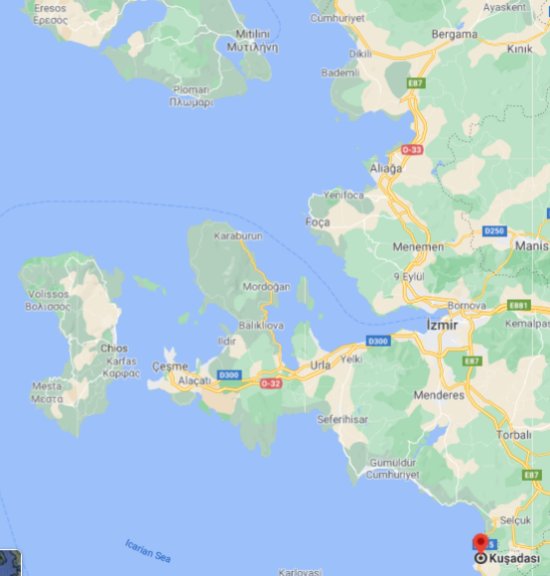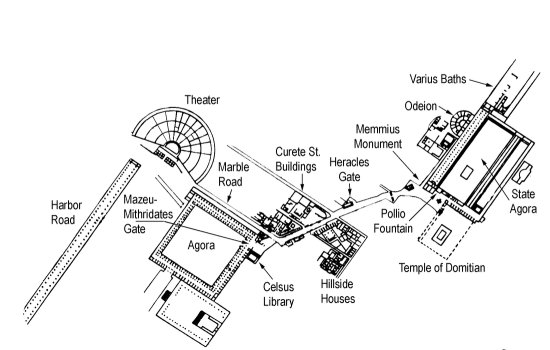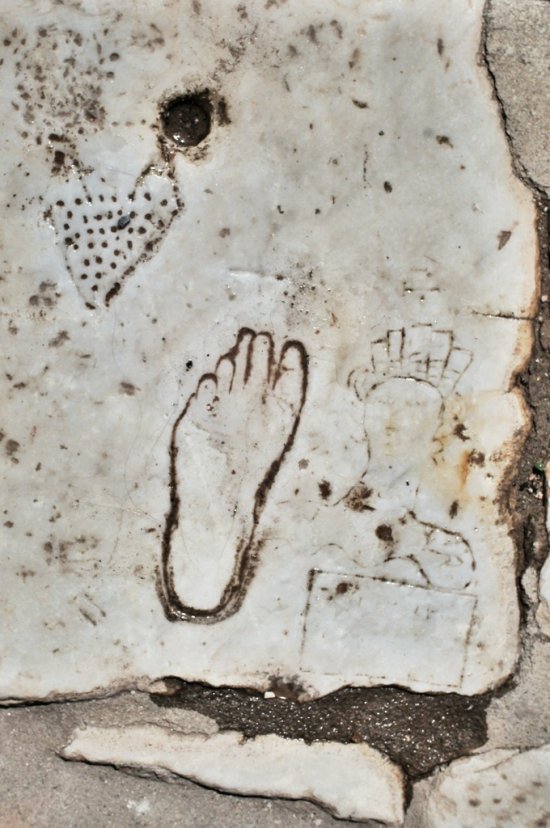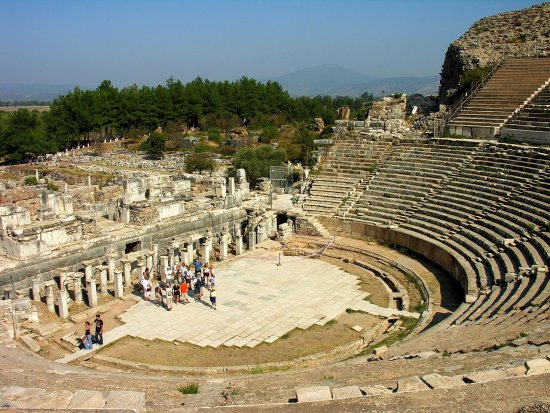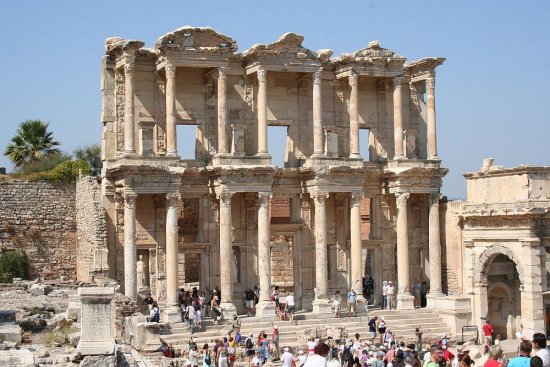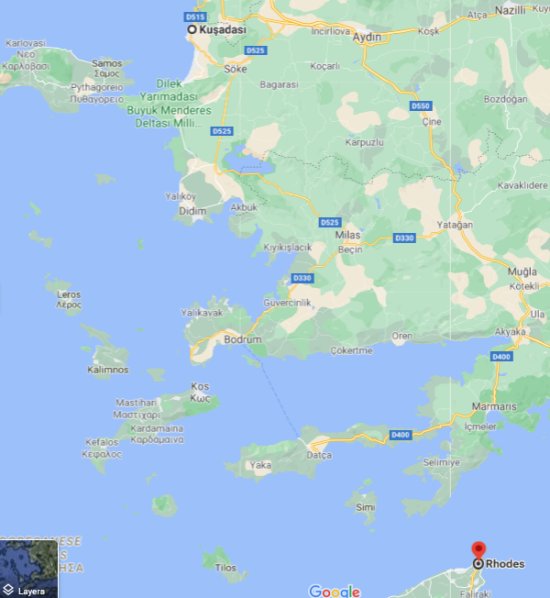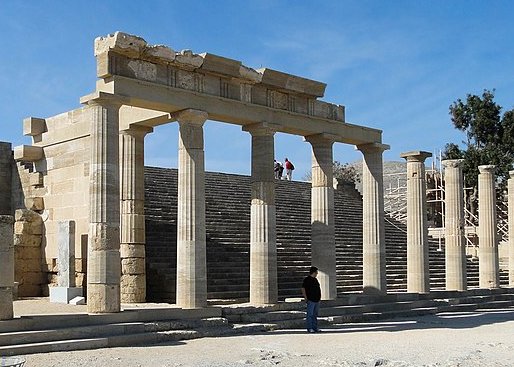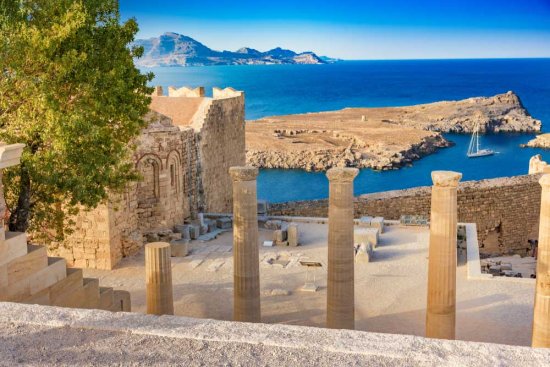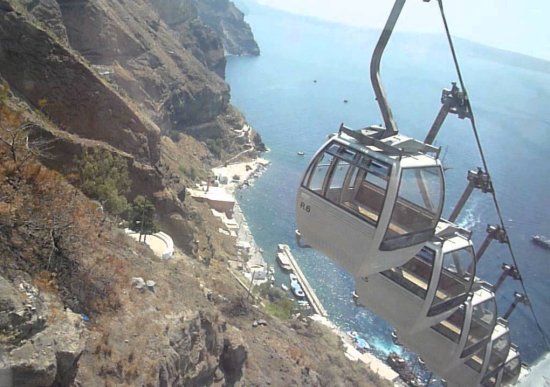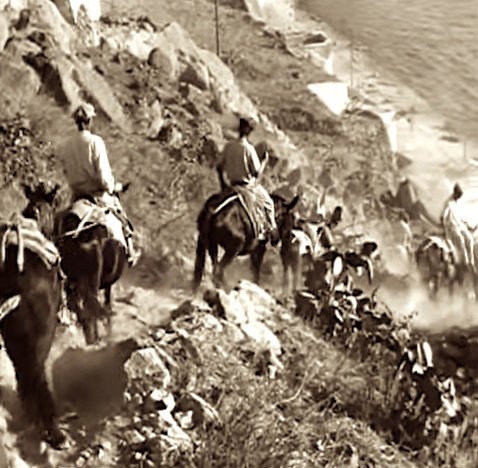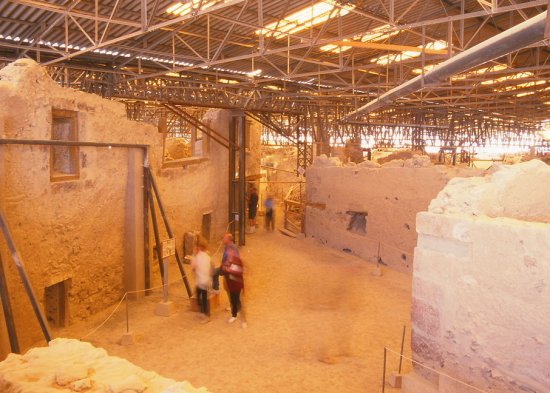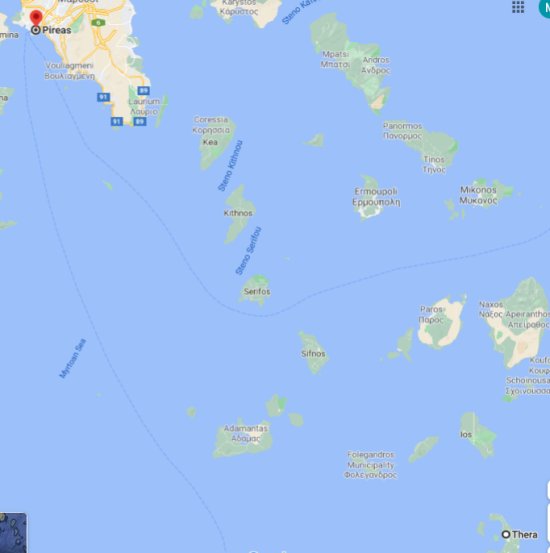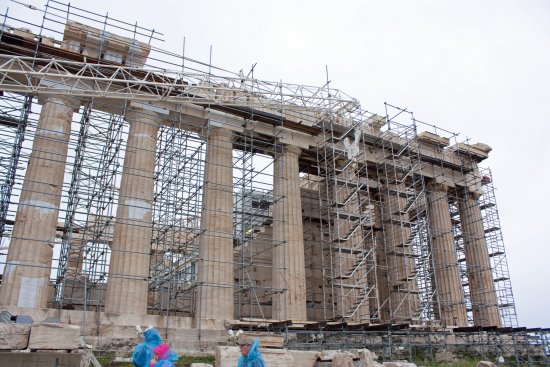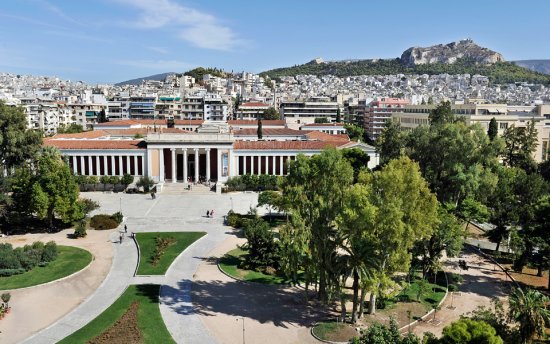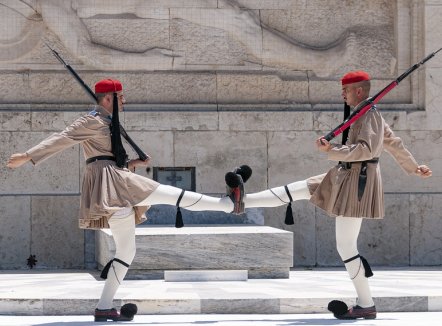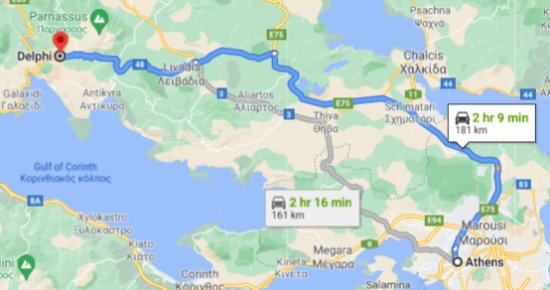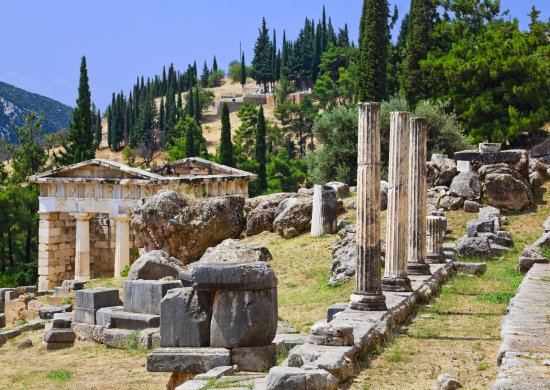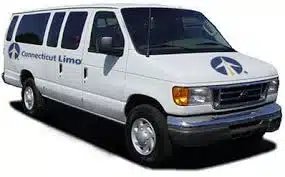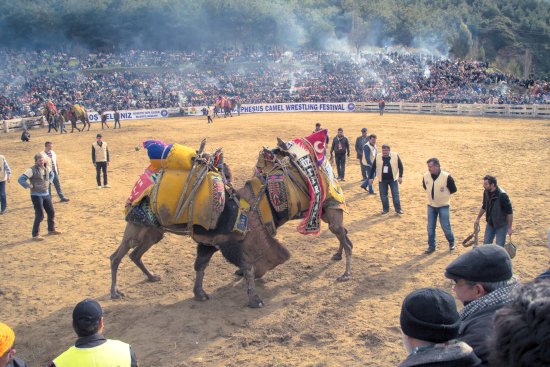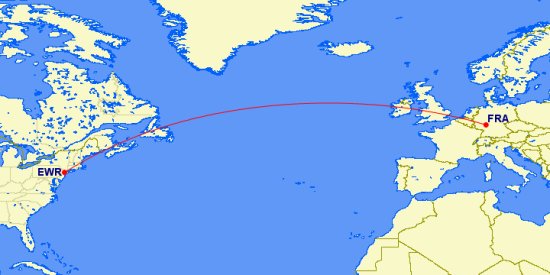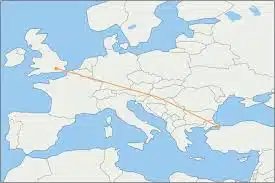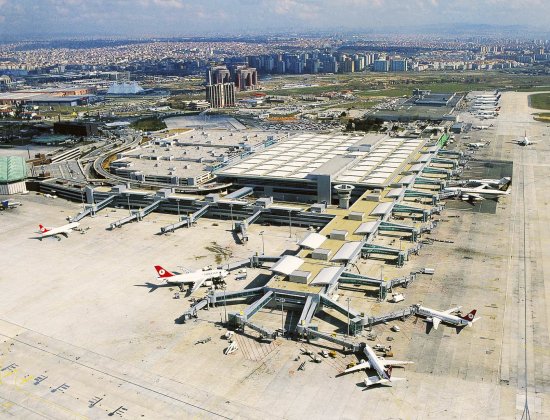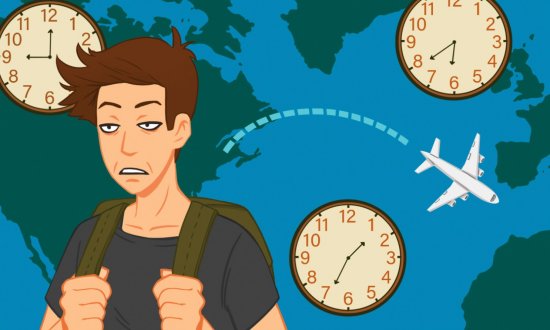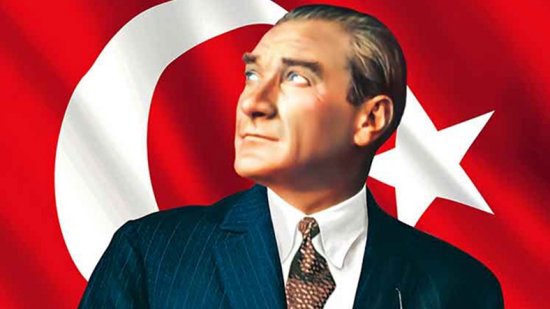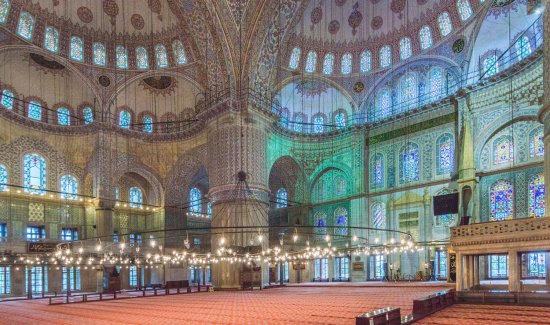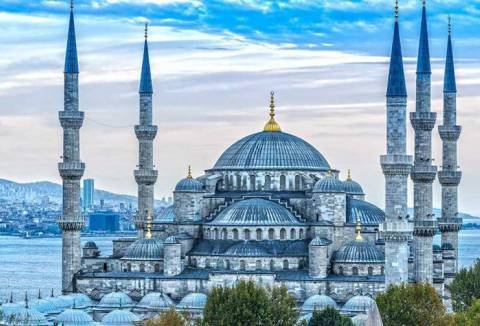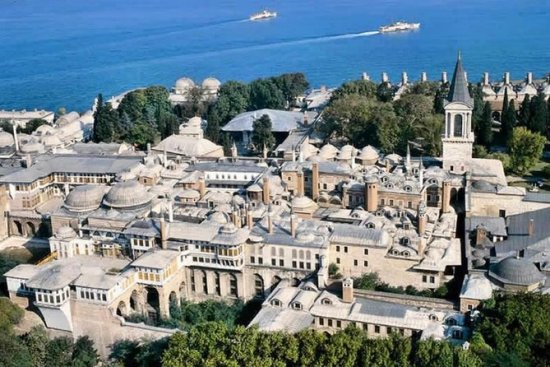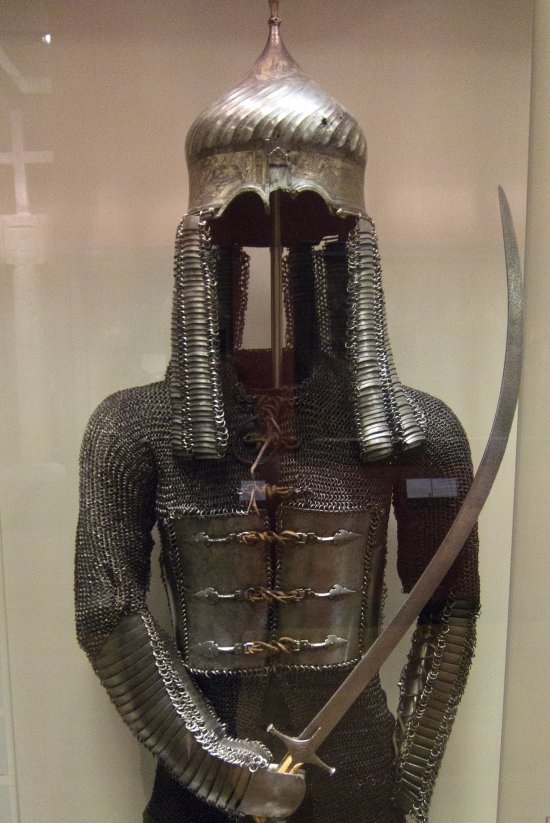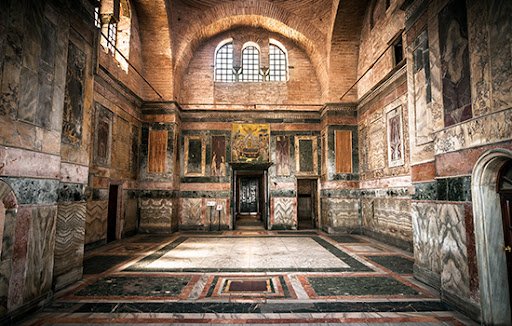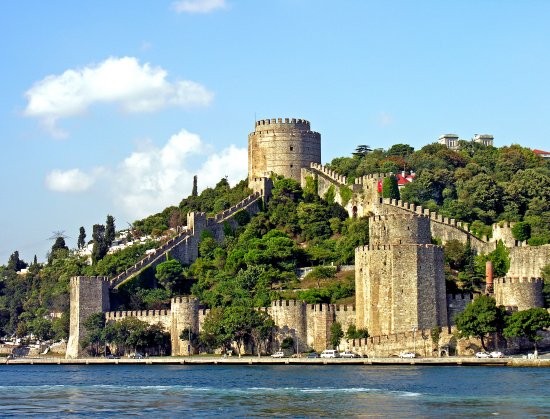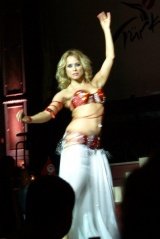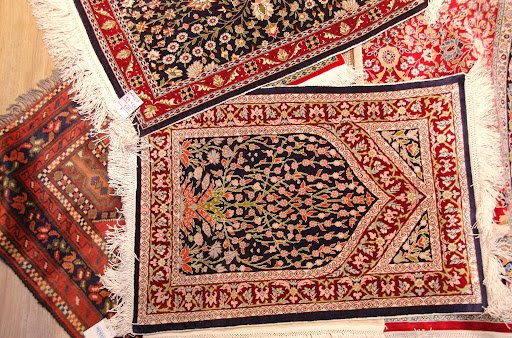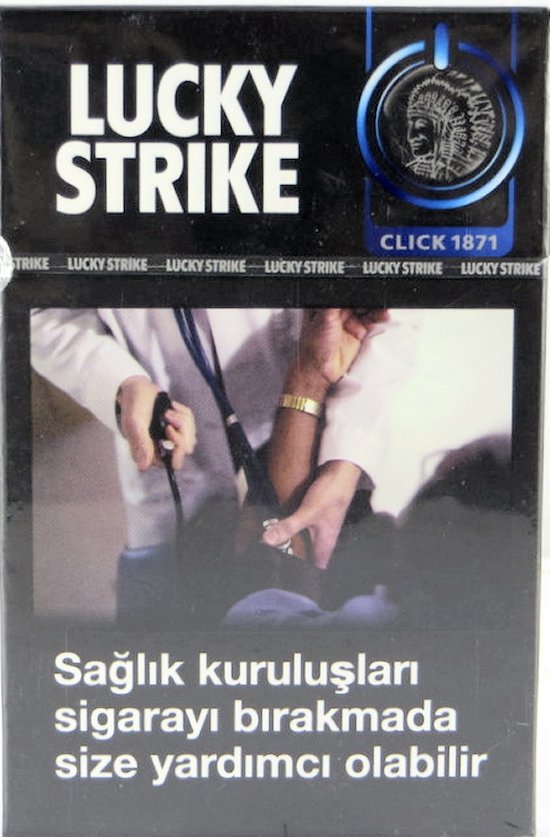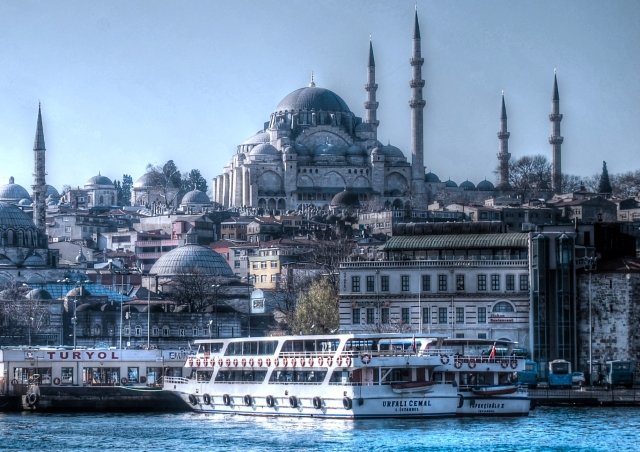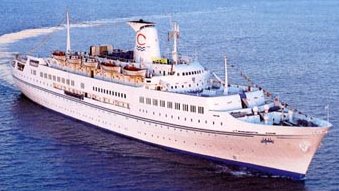Three Greek islands, Ephesus, Athens, and Delphi. Continue reading
Buses transported the entire group from the hotel to the ship, which was considerably smaller than the Song of Norway. This was actually a good thing. It was easier to get around on this ship, and almost all of our time on it would during the hours of darkness.
I think that we must have left Istanbul fairly late in the day. I don’t remember that we had any days at sea. In fact, I do not remember much about being on the ship at all. The schedule was pretty much the same every day. We were always in port when we woke up. We ate breakfast on the ship. Then we disembarked from the ship and did something. Then we returned to the ship. After we left the port we had supper. There was usually some kind of entertainment in the evening.
I remember absolutely nothing about the food. It must have been passable and fairly plentiful. In those days I was probably more interested in quantity than quality. The cost of the cruise was quite low. We did not expect to be treated the way that we were on our two Royal Caribbean cruises (described here).
Our room was OK, and the service at supper was, too. There were no assigned seats, and I don’t ever remember us sharing a table with anyone. I don’t remember our cabin boy, but we must have had one.
If we had had a day at sea, it might have been tiresome. The ship had none of the amenities that the Song of Norway boasted. There was definitely no casino. I don’t think that there was even a game room or an exercise room or anything like that. We did not miss these things; we came to see the sights. If we wanted a drink on the ship, we could get it.
After supper there was entertainment in a small theater. I remember three of the shows.
- A magician performed one evening. I was still quite interested in magic in 1992 even though more than a decade had passed since I had devoted a lot of time to it in Detroit (as described here). The magician came on stage wearing a flashy sport jacket and did at least six or seven “productions”—making things appear out of nowhere: flowers, a cane, a dove, a bunny, etc. Then he took off his jacket for the rest of the performance. I wonder how many other people thought, “Well, I guess that that jacket is empty now.”
- I seem to remember that there was a small orchestra/band on the ship. One night they played while some female dancers performed. Ordinarily I would have no interest whatever in such a show. However, Sue and I were within ten feet of one of the dancers when her left breast popped out of her costume. I paid attention after that.
- On the last night of the cruise as our ship was en route from Santorini to Piraeus, the orchestra played Greek music, and a gourp of the crew members got up on the stage and showed how to dance to Greek music. One fellow really got into it and tried to coax passengers into joining him for the finale. Only a few did. I think that this fellow may have hit the ouzo a little early that evening.
Our first port of call was Mytilene (mee tee LEE nee), the port city and capital of the Greek island of Lesbos (LEZ voss). Although Mytilene is only 184 miles from Istanbul by air, it was quite a bit farther by sea, perhaps 300 miles. The first phase of our voyage took us down to the base of the Bosphorus, across the entire width of the Sea of Marmara, through the Dardanelles, past the site of ancient Troy, down the western coast of Turkey, then an abrupt turn back to the east, and then south to the western side of Lesbos, where we were actually less than seven miles from Turkey and very far indeed from the Greek mainland.
Sue and I took a guided tour that included at least two stops on the island. About ten or twelve of us were in the group, as I recall. We traveled in a small bus. Our guide was a young lady who was very well spoken and enthusiastic about her home island and Greek heritage. She told us about the historic conflict between Greece, of which Lesbos is one of the most distant islands, and “Asia Minor”, which is how she always referred to Turkey. She also spoke about the Turkish Revolution that ended in 1923 and resulted in the Greeks being expelled from modern Turkey. She called this event “the Catastrophe”. How strange it must be to live in such an otherwise isolated area only a few miles away from your country’s ancestral enemy. I don’t know for certain, but I suspect that the families of most or the residents have been in Lesbos for centuries.
Our first stop was at the Theophilos Museum in the village of Vareia, just outside of Mytilene. Our guide explained that Theophilos Hatzimihail was an eccentric artist who was born in Vareia. She said that he was one of the few people who dared to wear the ancient historical garb, including a kilt and a curved sword. He also was a fanboy of Alexander the Great.
Theophilos’s works were generally very colorful and patriotic. He also often painted the locals of Lesbos engaged in mundane tasks. The guide said that they were like “cartoons”. Clearly she did not mean to disparage them. Instead, she was emphasizing that they told stories and were not necessarily realistic. Also, he also sometimes hand-wrote dialogue next to his characters, but he never used “balloons”.
I really enjoyed the visit to the museum. Theophilos was no Caravaggio, but I remember having a really good time looking at his paintings. and I had never felt that way before around art. Maybe it was just because the guide provided some context for me. It had a profound effect on me. It definitely affected the way that I approached subsequent trips.
After we left the museum the bus transported us into the interior of the island to another village. This one was, our guide assured us, locally famous for its beautiful church. I don’t remember the name of the village or the church. The church did not seem that special to me. It certainly was not as ornate as St. Bede’s church in Kelly, KS. The most memorable feature was the pair of nuns who cared for the church. I estimated that they were both about four feet tall.
After the visit to the church we may have stopped for lunch (I don’t remember) before returning to the ship. When I gave the guide her tip, I described the experience as “θαυμάσια”, which means “wonderful”.2 She was very surprised by this and smiled widely.
By the way, Sue did not share my enthusiasm about the excursion. Maybe I just had a slight crush on the guide.
During the night we sailed from Mytilene to Kuşadası, a port city on the Turkish mainland. The primary reason for this stop was to allow passengers to view the remains of the ancient city of Ephesus. Almost all the passengers elected to take the excursion.
Ephesus was for centuries one of the major cities in Asia Minor. It figured prominently in the early years of Christianity. There is even a letter to the Ephesians attributed to St. Paul.
I think that we had a guide for this visit, but I don’t remember him at all. Someone official certainly accompanied us on the bus trip to the site, which is about twenty miles from Kuşadası.
I remember that we were told that the city was a port in its heyday. However, the river and coastline silted up over time. The ruins are now about two miles away from the sea. By the fifteenth century the former city had been completely abandoned.
The ruins, however, were in pretty good condition. Perhaps the best aspect was that it felt like a real city, not just a group of isolated structures.
The one thing that both Sue and I remember the most clearly was the place where a footprint and a drawing in the paving stone have been interpreted as an advertisement for a local brothel. Our guide claimed that it was the oldest advertisement in the world.
The worst aspect was the fact that the site was guarded by soldiers with semi-automatic rifles. In 1992 this was a stunning sight. We were told that there might be a problem with Kurdish groups.
The building that impressed us the most at the time was the huge theater that could seat as many as 25,000. It was extremely well preserved. It took no effort at all to imagine a performance taking place there.
The other really impressive structure was the Library of Celsus. I remembered that the four virtues were celebrated in the facade, but the only one that I remembered was Sophia (wisdom). The other three—bravery, knowledge, and thought— I had to look up online.
The guide did not tell us about Jesus’s mother Mary being escorted to Ephesus by John the Apostle. Supposedly she lived in or near the city up until her last days on earth. However, no Catholic believes that she was buried in the vicinity—or anywhere else. One of the very few statements ever made by any pope under the terms of infallibility was that Mary was assumed into heaven body and soul at the time of her demise. Pope Pius XII made this declaration in 1950 in the Apostolic Constitution, Munificentissimus Deus.
Of course, I was quite familiar with the doctrine of the Assumption when we were in Ephesus in 1992, but I did not know about the papal declaration. What is surprising to me now is that it was not declared earlier. The Assumption has been a part of Christian (but not biblical) tradition for a very long time.
The next morning we landed in Rhodes, which is the name of both the port city/capital and the island on which it resides. The only thing that I previously knew about Rhodes was that it was the home of the Colossus of Rhodes, a huge statue that straddled the harbor. The statue disappeared many centuries earlier, but as our ship docked in that same harbor, and it was not difficult to visualize what the statue—one of the seven Wonders of the World—might have looked like in ancient times.
Rhodes was a very interesting place. A medieval wall circumscribed the Old Town. I walked the entire circuit by myself. It affoded great views both of the city on one side and the rest of the island, the harbor, and the sea on the other.
I was even able to read a few of the street signs. I recall that one of the streets was named ίππος, a common word from Homer’s time that is still used. It means horse. If he had ever written it, Homer would have placed a rough breathing mark at the beginning to indicate an /h/ sound. Modern Greek has dispensed with that character and that sound.
For centuries Rhodes was home base for the Knights of St. John, often called the Hospitalers. Several castles and palaces that they used remained on the island. I think that there were excursions available to visit some of them, but we did not take advantage of them.
Instead, we went to the nearby town of Lindos, which is pronounced like “LEAN those”, except that the last consonant sound is an /s/, not a /z/. It has a nice beach, but it is most famous for its Acropolis. One of the most stunning events of my life was climbing the very wide Staircase of the Propylaea there. Sue recalls ladies who sat on the steps selling home-made lace products.
Nothing but sky was visible at the top as one ascended the stairs. It was a surreal experience. However, when the top was finally reached, the view in every direction was absolutely stunning—ruins of the church of St. John, the sea, the village, the beach. It was almost too much for the senses to handle.
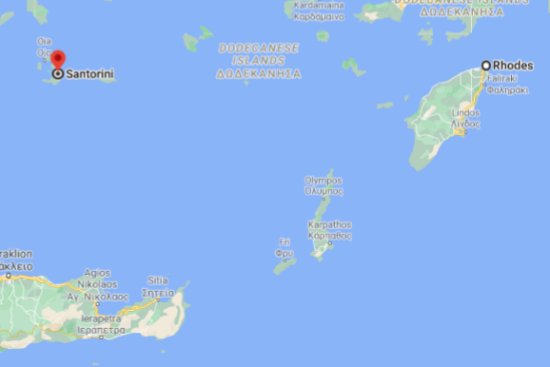
During the night we sailed west toward our final island, the picturesque Santorini. We knew nothing about it until we arrived there.
The small island is a long way north of Crete, but an event there had a large effect on the Minoan civilization that was based on its much larger neighbor to the south. That is because circa 1600 BC the volcano on Santorini (which was then one single island called Thera) erupted massively3 and buried the settlement at Akrotiri on the southern part of the island. It also caused tidal waves and earthquakes that wiped out the Minoan civilizations on Crete and other islands.
The caldera of the volcano, which has became the harbor after the eruption is surrounded by very steep cliffs. The capital city of Fira and, from there, the rest of the towns and villages, can be reached by road. One way to get to the top is to ride a donkey. A faster way is to take the cable car. Both Sue and I remember exploring Fira and having lunch at a restaurant there, but neither of us remember how we got up and down. We definitely did not ride donkeys. We must have taken a cable car.
In the afternoon we took a bus to the archeological site of Akrotiri. This was the most informative and interesting excursion of the entire trip. When we arrived, the excavation was in its twenty-fifth year. These are probably the best preserved ruins ever discovered, and large portions of them were open for public viewing.
Our guide told us about some of the artifacts that were found here. It is indisputable that the merchants of Akrotiri traded with people from all over the Mediterranean. A large amount of written material was also discovered. It is in a language called Linear A. Unfortunately, we were told that no one has been able to decipher it.4
During our last night at sea the ship sailed northwest from Santorini (which Google Maps sometimes still calls Thera) to Piraeus, the port for Athens. We were then taken by bus to the hotel. During the drive we passed the Panathenaic Stadium in which some of the events of the first modern Olympics were held in 1896. We also were surprised to see a statue of Harry Truman, who was honored there because of the Marshall Plan that was implemented during his administration.
Most of the group took the excursion to the Acropolis. How could you visit Athens without seeing the Acropolis? Actually, I was a little disappointed by the Parthenon. It definitely was impressive to see from anywhere in Athens5, but when we finally arrived there, we discovered that a good bit of it was covered by scaffolding. So, for me at least, this was mostly just a matter of “ticking the box” on the bucket list. I did learn one new word that actually stuck in my memory: Caryatid.
The only social interchange with any of the other tour members that I can remember occurred while we were standing around on the Acropolis. As we looked down on Athens sprawling beneath us, we got into a conversation with two young ladies from the West Coast. They were interested that we owned a business, which we accurately described as “struggling”. One of the women astutely pointed out that we could not be doing too badly if we could afford to take a nice vacation like the one that we had both experienced. It was a nice thing for her to say, and it improved my mood.
After we had wandered around the Acropolis for the allotted period of time the bus drove us down to the National Archeological Museum in the center of Athens. Although I am absolutely positive that we visited it, I don’t honestly remember anything about it at all. If you want to know what is in it, I recommend that you watch the nine-minute video that is posted here.
At the hotel we had picked up a pretty good street map of Athens. I talked Sue into walking back from the museum to the hotel. If we became too tired or sore at some point, we could probably flag down a taxi. Incidentally, the taxi drivers in Athens were almost indistinguishable from the ones in Istanbul—same gender, same mustaches, same cigarettes held at all times in the right hand.
I wanted to stop at a clothing store or sports store in Athens to try to buy soccer jerseys with team names in Greek for my nieces. We stopped in a few places, but I don’t think that we found anything of that nature that was very appealing. The retailers in the center of Athens were mostly oriented toward selling souvenirs or very expensive stuff to tourists. It may be that the fad of wearing fake jerseys had not yet reached Greece in 1992.
At one point in the journey back to the hotel we stopped for a rest. Sue and I were resting on a low wall. An elderly woman approached us and addressed us—in Greek, of course. As quickly as I could, I tried to form the most useful short sentence that I could think of: “Δεν καταλαβαίνω,” which means “I don’t understand.” Before I could get the first word out, she correctly diagnosed our ignorance of her native language, turned her back and walked away. By the way, that first word, “Δεν”, is pronounced almost exactly like the English word “then”.
We happened to pass the home of the Prime Minister of Greece just as they were performing the ceremony of the changing of the guards. The soldiers wore absolutely absurd costumes, and their marching style would certainly have qualified them for the Ministry of Silly Walks. If the Turks frightened their enemies with their mustaches, the shoes of the Greek soldiers must have disabled their foes with uncontrollable laughter.
Sue and I had a good time at supper describing these guys to some of the other members of our tour group who had gone to the same restaurant. The atmosphere was festive, but the food was at best mediocre.
On our last day we took a bus to Delphi, the home of the famous oracles. The highlight of the trip occurred just as we made the turn to the west. I saw a sign for Marathon. It was fun to imagine the messenger making his fatal run from Marathon back to Athens along the same route that we had driven. I could visulaize him prostrate near the stadium as he called out in a strained voice, “Νίκη!”
Delphi itself was another disappointment to me. We got to hear the story of the oracles, and we saw the ruins along the side of a hill from a distance, but we were not allowed to get very close to them.
In point of fact, at this point in the trip we had seen about as many ruins as we needed to see. We had viewed a large number of broken columns and ruined buildings. At this point we would rather have dealt with something alive or at least intact.
Sue and I enjoyed this trip immensely. It seemed regretable that the only really disappointing day was the last one. I think that the trip would have worked better if it had been in the opposite direction—starting in Athens and ending in Istanbul. That would have put the most impressive ruins at Ephesus closer to the end and the one island with no ruins at all, Lesbos, just before Istanbul.
We flew back to JFK Airport on Long Island. The trip was completely uneventful; at least I don’t remember any problems. My recollection is that a limousine service brought us back to Enfield. In those days a company called CT Limo6 specialized in driving between the Hartford area and the international airports around New York City. Their prices were competitive; if not, I would never have agreed to such an extravagance.
1. Her attitude to me seems strange in retrospect. The Ottomans conquered Turkey in the fifteenth century. A few Christians still lived there, but the Turks were dominant until the end of World War I. At that point the allies and Greeks tried to impose a government on the area, but the Turks revolted and won their autonomy. So, she was really pining for a time that had been erased from history more than five hundred years earlier.
2. The word is pronounced, believe it or not, “thahf MAHS ee ah”. The alpha-upsilon diphthong in modern Greek is pronounced “ahf” or “ahv”, depending on the next letter. Upsilon is still a vowel when used alone, but when used with another vowel it has developed a consonant sound.
3. The volcano is still considered active. It last erupted in 1950. The ones in the 1920’s were more serious and caused some damage.
3. Volcano
4. Little progress has been made in the subsequent years. When I heard about this my first thought was that I would love to work on this project.
5. Mark Twain’s stealthy visit to the Parthenon is described beautifully in The Innocents Abroad. He was quarantined on the ship, but a group of men snuck ashore, made their way to the Acropolis and visited it by starlight.
6. CT Limo still exists and still offers this service.


